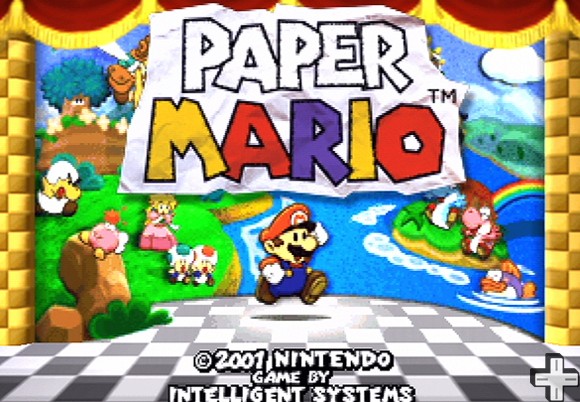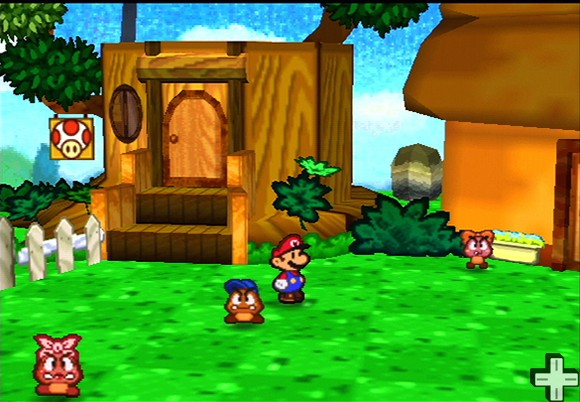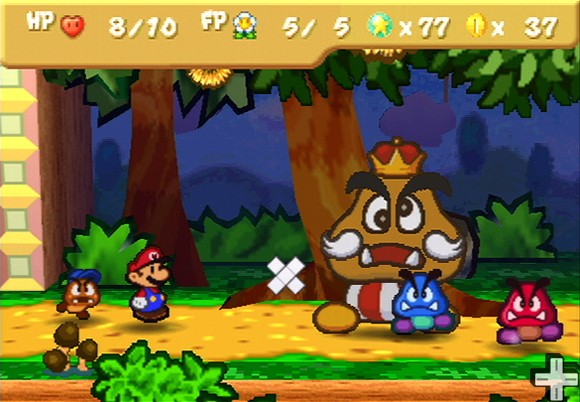Game: “Paper Mario”
Paper Mario

Mario, he’s a man of few words, and a name of even fewer. It’s been a long time since Mario Mario hit the arcades and managed to take the world by storm. He’s now easily one of the most recognisable characters in the world with few other mascots reaching such fame. However, it’s not always been a good thing to fall in the Nintendo camp and towards the end of the 90’s, early 2000’s this was one of those times. The Nintendo 64 was being destroyed in terms of sales and third party support by PlayStation and people just stopped caring for the powerhouse of a system.
It was towards the end of these doomed days that a little game hit the market, one that many fans managed to miss due to trading in their N64’s long ago – Paper Mario. Paper Mario took the Mario franchise in the UK in an entirely new direction, by not only squashing a 3D world into a 2D stylised one, but also by introducing role-playing-game elements into Mario. This was brand new in the UK, as Mario RPG at the time had not made its way across to our shores.
Paper Mario uses the classic tale of all Mario games – Peach gets kidnapped by Bowser, after all, it wouldn’t be a Mario game if that didn’t happen. However, unlike most Mario games, Mario is actually the weaker of the two and has to battle his way through a number of trials and tribulations that means he has to travel the length and breadth of Mushroom Kingdom in order to save his princess.
There’s also a heavy emphasis on story in Paper Mario. Unlike most Mario games where it’s pretty much jump from painting to painting, pipe to pipe or world to world, Paper Mario has a somewhat complex backstory. Mario also has to enlist the support of a wide number of partners who will battle alongside Mario in the quest to save Princess Peach and Mushroom Kingdom from the evil King Bowser.
It’s clear from the off that Paper Mario often has a worrying lack of faith in the characters, with plenty of hints and tips given by various people in the towns and villages. This lack of faith makes Paper Mario a great quest for first time players, but for more seasoned players it can take away the elements of mystery and surprise. With the majority of the NPCs giving tips and actual wizards and fortunetellers at various stops, battling your way through the game isn’t a particularly challenging experience.
Yet, what really makes Paper Mario stand out from the crowd is it’s easy and enjoyable battle system. Unlike many JRPGs, there are no random battles, so there’s no worry about walking along a path and suddenly being attacked by an enemy, which is a problem so prevalent in the Final Fantasy series, they are clearly visible and avoidable if that’s what you want to do. However, if and when a battle arises, rather than there being a complex series of menus with statistics flying around the screen and being attacked whilst waiting to choose which move you want to use, it’s a simplistic and easy to read navigation menu with a complete “turn based” element of gameplay. There’s also ways and means of defending yourself from attacks mid attack and increasing your power by simply hitting A at a certain time.
With additional options such as Flower Points, this is the equivalent of magic in a fantasy styled game. Badge points, which allow Mario to wear “badges” that give him special abilities, from being able to see the health of his opponents to special abilities to collect more coins at the end of the battle. Finally, there are Stars, who are a key and one of the most important elements of the game. They are almost like the extra magic attack that everyone wants and have limited usage.
This mixed with the animation is what really makes Paper Mario and memorable game. Although Mario is paper, the world is 3D and there’s a clear depth in the levels, characters and rooms. This 2D action in a 3D world is only made better by the clear animation, visibly high framerate and excellent character models. The game is anything but dull, with vibrant bosses, enemies and towns, all of which are recognisable and distinct. At no point are you looking at the game wondering what sort of enemy it is, it’s clear who and what they are. Further, by using the classic enemies and characters from older Mario games, it feels like Mario could always have been in this RPG style.
Paper Mario is easily one of the best games released on the Nintendo 64 and should be ranked up there with the likes of Ocarina of Time, Mario 64 and Super Smash Bros; however, due to the strange nature of the game and the time it came out it’s become a lost classic with sequels overshadowing it’s achievements.









